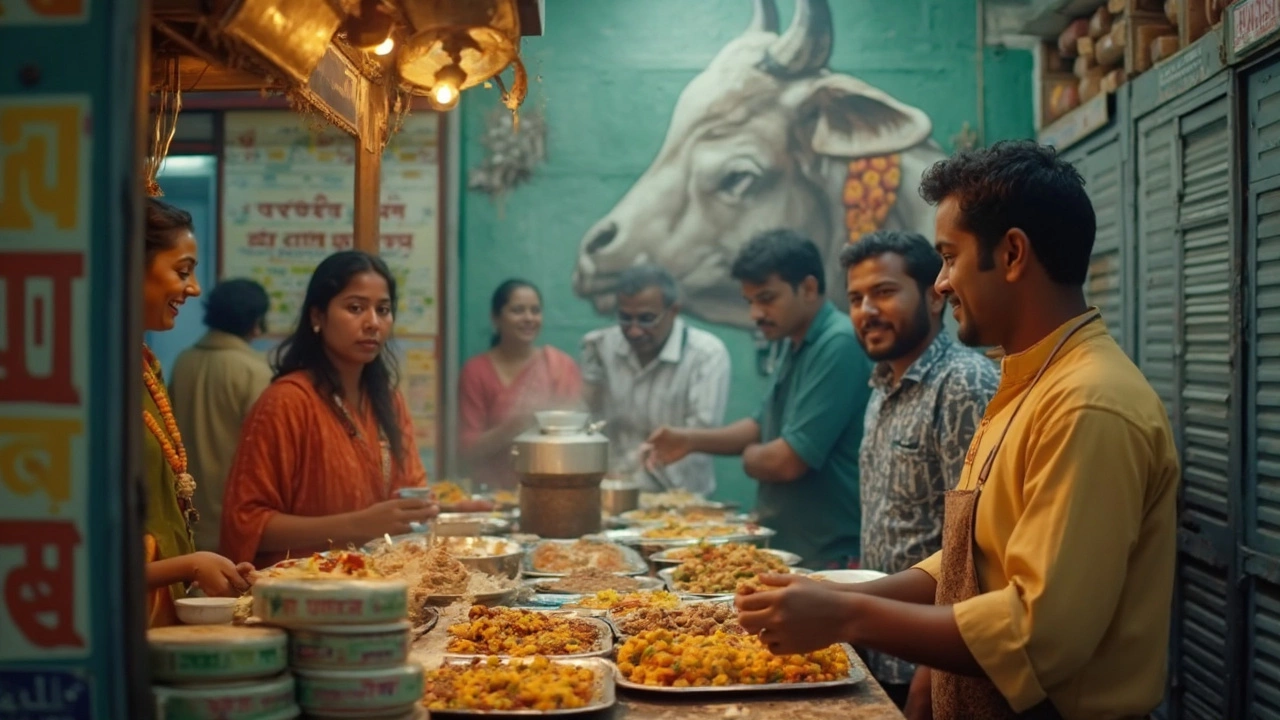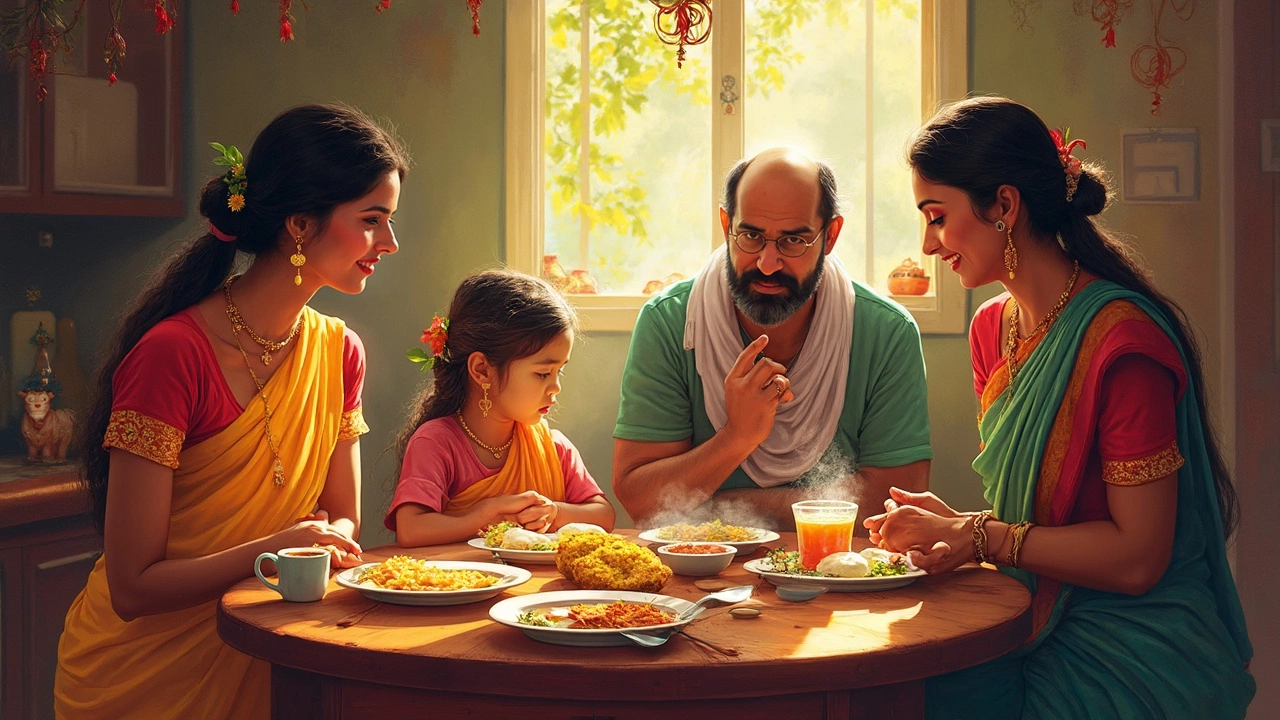Ever been to a breakfast spot in India and noticed beef is nowhere in sight? There's a big reason behind that. For most Hindus, eating beef feels about as strange as putting ketchup on cereal—it's just not done, but the reason goes way deeper than personal taste.
This choice is tied to ancient beliefs and the special place the cow holds in Hindu culture. Most Indian breakfast dishes—think poha, upma, or idli—skip beef altogether. Even at home, breakfast spreads revolve around veggies, grains, and dairy.
If you're traveling in India or want to cook an Indian-style breakfast, there’s zero need to worry about accidentally serving beef. In fact, knowing why beef is avoided gives you a bigger window into Indian life and helps you plan meals that everyone at the table can enjoy without a hitch.
- The Cow’s Special Place in Hinduism
- Why Beef Is Off the Table
- How This Affects Indian Breakfasts
- Smart Breakfast Tips Anyone Can Use
The Cow’s Special Place in Hinduism
Ask anybody in India about the cow, and you’ll probably get a story, not just an answer. Cows aren’t just animals here—they’re seen as family members in many Hindu homes. The main reason goes way back: ancient Hindu texts, like the Vedas (that’s over 3,000 years ago), describe cows as symbols of wealth and kindness. For most Hindus, the cow is a sign of giving, because it provides milk, butter (ghee), and dung, which people use as fuel and fertilizer.
Why the special treatment? In Hindu stories, gods like Krishna grew up as cowherds. Krishna, one of the most loved and mischievous gods around, is literally shown hanging out with cows and stealing butter. It’s not just stories either—the cow actually shows up in everyday life and rituals. During Diwali and other festivals, some families even decorate cows just like people.
Respect for cows shows up in numbers too. Check out how much milk is a part of daily life in India:
| Year | Milk Production in India (million tons) |
|---|---|
| 2000 | 78 |
| 2010 | 112 |
| 2020 | 198 |
India is the world’s top milk producer, and a lot of that is thanks to the respect for the cow. This love for dairy shapes the kind of food that ends up on the breakfast table every morning—think paneer, yogurt, and Indian breakfast drinks made with milk. So, avoiding beef is not just about religion—it’s about keeping the bond with an animal that gives so much and ties together culture, faith, and daily food.
Why Beef Is Off the Table
So, why is beef basically invisible from Hindu meals? Let’s get right to the facts. The cow is deeply respected in Hinduism. It's seen like a second mother—one that gives nourishing milk and helps out on the farm. This isn’t just an old story. Around 80% of India’s population is Hindu, and you’ll see cows wandering freely in cities, towns, and villages. People often stop traffic to let them pass. That’s real respect.
This ties back to ancient Hindu texts, like the Vedas, where cows show up as symbols of life and strength. Temples sometimes even shelter stray cows, showing how serious this respect is. Killing cows or eating beef not only goes against religious rules, but it’s also against the law in most Indian states. That’s right—most states have strict bans on beef, with real consequences for breaking them.
Here’s a snapshot of current beef laws in India:
| State | Beef Sale Allowed? | Penalty for Violation |
|---|---|---|
| Uttar Pradesh | No | Up to 10 years jail |
| Maharashtra | No | Up to 5 years jail |
| Kerala | Yes | No ban |
| West Bengal | Yes (with restrictions) | Fines/jail possible |
You might ask: is this strictly religious, or a cultural thing too? It’s both. Even those who aren’t deeply religious may skip beef to respect family or community traditions. Walk into most homes, restaurants, or local breakfast joints, and beef isn’t even on the menu—major food brands don’t touch it either.
So if you’re planning an Indian-style meal or a breakfast get-together, understanding this helps you avoid awkward moments and shows real respect for your friends’ beliefs. The bottom line? For Hindus, not eating beef isn’t about missing out—it’s about honoring community and the values they grew up with.

How This Affects Indian Breakfasts
The lack of beef in everyday Indian breakfasts isn’t just about avoiding a single food—it shapes the whole menu. People across India swap out beef for other proteins or leave out meat entirely. The focus turns to dairy (like yogurt and ghee), lentils, fresh veggies, and grains. You’ll spot classics like poha (flattened rice), dosa, idli, and parathas front and center every morning, and none of them ever include beef.
Even if you eat out—from a five-star hotel buffet to a roadside stall—finding beef on the breakfast menu is nearly impossible, especially in places with a big Hindu population. Check out this quick breakdown of popular breakfast foods from different regions of India and the typical main ingredients:
| Dish | Main Ingredients | Region |
|---|---|---|
| Poha | Flattened rice, spices, peanuts | Madhya Pradesh, Maharashtra |
| Idli | Fermented rice and lentils | Tamil Nadu, Karnataka |
| Paratha | Whole wheat flour, vegetables, butter | Punjab, North India |
| Upma | Semolina, vegetables, spices | South India |
| Dhokla | Fermented rice, chickpea flour | Gujarat |
When you think about the Hindus' choice to avoid beef, it’s clear why animal proteins in breakfast usually come from eggs or dairy (if at all). In fact, about 30% of Indians follow a vegetarian diet, and even among those who eat meat, chicken or mutton is much more common than beef. The vibe is more about family, tradition, and freshness, rather than loading up on heavy meats in the morning.
For anyone hosting Hindu guests, it’s smart to stick with vegetarian breakfast foods or make sure any meat options don’t include beef. You'll never go wrong with a spread featuring fresh fruits, creamy yogurt, homemade chutneys, and warm bread straight from the pan.
Smart Breakfast Tips Anyone Can Use
If you’re planning breakfast in India, or for Hindu friends, there’s a simple rule: skip beef and focus on everything else the Indian kitchen is famous for. Sticking to common grains, veggies, dairy, and fruit means you can whip up something quick, tasty, and respectful—no kitchen stress.
Some of the most loved Indian breakfasts are naturally beef-free and super easy to adapt. Here’s what you can rely on:
- Poha: Flattened rice cooked with onions, turmeric, green peas, peanuts, and a squeeze of lemon. Done in 15 minutes.
- Upma: Savory semolina with veggies—carrots, peas, and onions are classics.
- Parathas: Flatbreads stuffed with spiced potatoes or cauliflower, often paired with yogurt.
- Idli & Dosa: Steamed rice cakes and crisp rice pancakes, served with chutney and sambar.
- Porridge: Oats or millets with milk and fruit—quick and filling.
If you love protein in the morning, just swap beef for Indian-friendly options like paneer (fresh cheese), boiled eggs, chickpeas, or lentils. You’ll get all the nutrition, without stepping on any toes.
| Ingredient | Popularity (%) |
|---|---|
| Dairy (Milk, Yogurt, Paneer) | 73 |
| Vegetables | 80 |
| Eggs | 33 |
| Beef | <3 |
| Lentils/Legumes | 67 |
One practical tip: always ask about dietary preferences if friends or family are joining you. Hindu families might also avoid eggs or all animal products—but no one will bat an eye if you offer tasty veggie options. And if you’re stocking your kitchen, you can’t go wrong with rice, lentils, fresh veggies, and dairy products like ghee or yogurt.
The golden rule? You don’t need beef to have a full, satisfying breakfast in India. Your tastebuds (and guests) will thank you.
